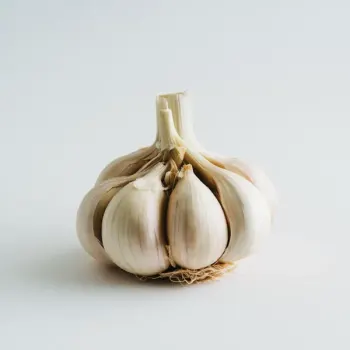Garlic and celery are two distinct ingredients used in cooking. Garlic, a flavorful bulb, adds a pungent aroma and is used in smaller quantities, while celery offers a crunchy texture and mild taste, suitable for larger amounts in various dishes.

Garlic is a pungent, aromatic bulb used as a seasoning or condiment in various cuisines. Its intense flavor enhances savory dishes, making it a cornerstone of flavor for many recipes.

Celery is a crisp, fibrous vegetable with a mild, slightly peppery flavor. Often used to add a crunchy texture or as a base flavor in soups, stews, and salads, celery is a versatile ingredient.
Garlic and Celery differ vastly in taste, texture, and culinary use. Garlic has a strong, spicy flavor that mellows and sweetens upon cooking, while celery provides a light, refreshing taste and a satisfying crunch. Garlic is often used in smaller quantities due to its potency, whereas celery can be used in larger amounts as a vegetable component in dishes.

Your ultimate Recipe Box, Meal Planner, and Cooking Class all in one
Garlic is used in soups and stews to infuse the broth with a deep, savory essence. It pairs well in hearty bean soups, lentil stews, and meaty broths, adding layers of flavor. For a well-rounded taste, sauté garlic before adding liquids. Celery acts as part of the classic mirepoix or soffritto in soups and stews, providing a subtle, earthy base flavor. It works well in chicken noodle soup and vegetable stews. Celery should be added early in the cooking process to soften and release its flavors.
In stir-fries, garlic provides a quick hit of flavor that permeates the dish. It's excellent in stir-fried greens, beef, and seafood, giving a sharp accent. Add garlic early to infuse the oil but be careful not to burn it. Celery adds a crunchy texture and a fresh contrast in stir-fries. It pairs well with peppers, onions, and carrots and can be used in both meat and vegetarian dishes. Slice celery thinly and add midway through cooking to retain some crunch.
Garlic can be used in dressings to add a punchy, assertive flavor to salads. It's especially good in Caesar salad dressing or a garlic vinaigrette. Fresh garlic should be minced finely or crushed in a press. Celery contributes a refreshing crunch and mild flavor to salads. It's a great addition to potato salads, coleslaws, and garden salads. To maintain the crispness, add celery just before serving.
Garlic is known for its potential health benefits, including anti-inflammatory and antioxidant properties, while celery is low in calories and contains a good amount of dietary fiber.
| Nutrient | Celery ( per 100 grams ) | Garlic ( per 100 grams ) |
|---|---|---|
| Fat | 0.17g | 0.5g |
| Sodium | 80mg | 17mg |
| Protein | 0.69g | 6.36g |
| Calories | 16 | 149 |
| Carbohydrates | 2.97g | 33.06g |
| Dietary Fiber | 1.6g | 2.1g |
While celery will not replicate the flavor of garlic, it can be used to add a milder taste to dishes where garlic's pungency is not desired.
Both garlic and celery offer health benefits. Garlic is recognized for its medicinal properties, while celery is a low-calorie food that contributes to hydration and provides fiber.
Garlic should be stored in a cool, dry place with good air circulation, while celery is best kept wrapped in the refrigerator to maintain its crispness.
Absolutely. Garlic and celery can complement each other in many dishes, such as soups and stews, to build flavor complexity.
Garlic is best minced or crushed to release its flavor, while celery can be chopped or sliced depending on the desired texture in the dish.